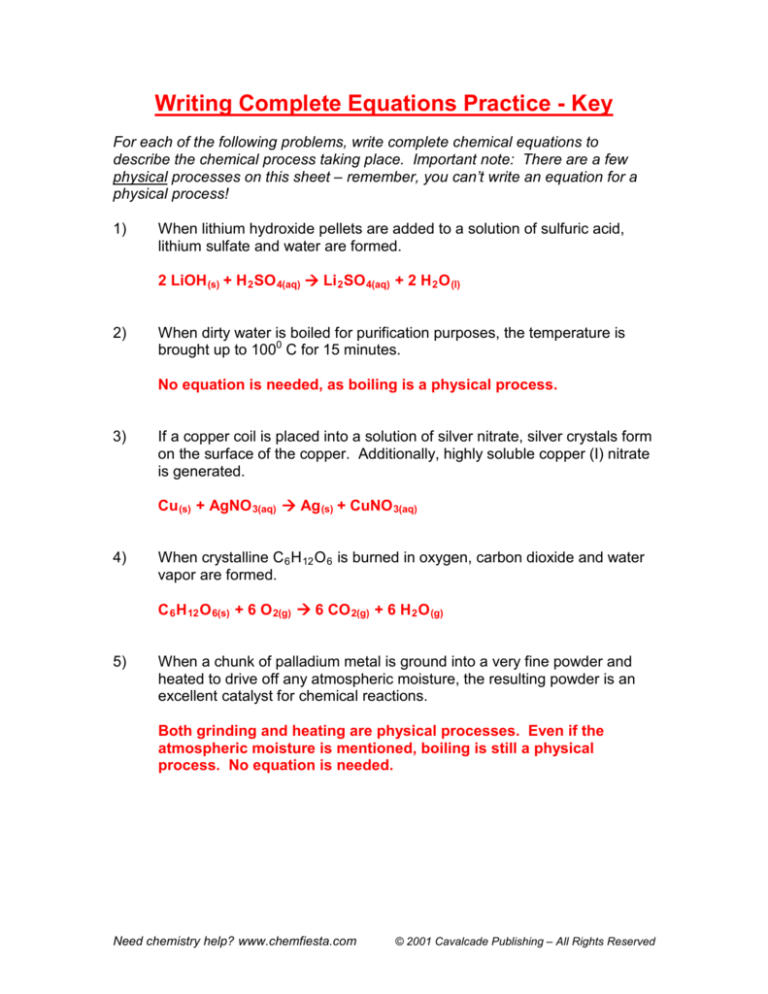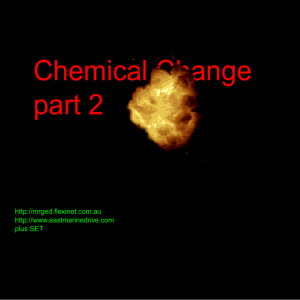
Writing Complete Equations Practice - Key
For each of the following problems, write complete chemical equations to
describe the chemical process taking place. Important note: There are a few
physical processes on this sheet – remember, you can’t write an equation for a
physical process!
1)
When lithium hydroxide pellets are added to a solution of sulfuric acid,
lithium sulfate and water are formed.
2 LiOH (s) + H 2 SO 4(aq) Li 2 SO 4(aq) + 2 H 2 O (l)
2)
When dirty water is boiled for purification purposes, the temperature is
brought up to 1000 C for 15 minutes.
No equation is needed, as boiling is a physical process.
3)
If a copper coil is placed into a solution of silver nitrate, silver crystals form
on the surface of the copper. Additionally, highly soluble copper (I) nitrate
is generated.
Cu (s) + AgNO 3(aq) Ag (s) + CuNO 3(aq)
4)
When crystalline C 6 H 12 O 6 is burned in oxygen, carbon dioxide and water
vapor are formed.
C 6 H 12 O 6(s) + 6 O 2(g) 6 CO 2(g) + 6 H 2 O (g)
5)
When a chunk of palladium metal is ground into a very fine powder and
heated to drive off any atmospheric moisture, the resulting powder is an
excellent catalyst for chemical reactions.
Both grinding and heating are physical processes. Even if the
atmospheric moisture is mentioned, boiling is still a physical
process. No equation is needed.
Need chemistry help? www.chemfiesta.com
© 2001 Cavalcade Publishing – All Rights Reserved
Word Equations – Answer Key
1)
Zinc and lead (II) nitrate react to form zinc nitrate and lead.
Zn + Pb(NO3)2 Zn(NO3)2 + Pb
_______________________________________________________________
2)
Aluminum bromide and chlorine gas react to form aluminum chloride and
bromine gas.
2 AlBr3 + 3 Cl2 2 AlCl3 + 3 Br2
_______________________________________________________________
3)
Sodium phosphate and calcium chloride react to form calcium phosphate
and sodium chloride.
2 Na3PO4 + 3 CaCl2 6 NaCl + Ca3(PO4)2
_______________________________________________________________
4)
Potassium metal and chlorine gas combine to form potassium chloride.
2 K + Cl2 2 KCl
_______________________________________________________________
5)
Aluminum and hydrochloric acid react to form aluminum chloride and
hydrogen gas.
2 Al + 6 HCl 3 H2 + 2 AlCl3
_______________________________________________________________
6)
Calcium hydroxide and phosphoric acid react to form calcium phosphate
and water.
3 Ca(OH)2 + 2 H3PO4 Ca3(PO4)2 + 6 H2O
_______________________________________________________________
7)
Copper and sulfuric acid react to form copper (II) sulfate and water and
sulfur dioxide.
Cu + 2 H2SO4 CuSO4 + 2 H2O + SO2
_______________________________________________________________
8)
Hydrogen gas and nitrogen monoxide react to form water and nitrogen
gas.
2 H2 + 2 NO 2 H2O + N2
For chemistry help, visit www.chemfiesta.com
© 2000 Cavalcade Publishing – All Rights Reserved
Worksheet: Writing Equations
Write equations for the following reactions:
1)
The reaction of ammonia with iodine to form nitrogen triiodide (NI 3 ) and
hydrogen gas.
3 NH 3 + 3 I 2 2 NI 3 + 3 H 2
2)
The combustion of propane (C 3 H 8 ).
C 3 H 8 + 5 O 2 3 CO 2 + 4 H 2 O
3)
The incomplete combustion of propane to form CO and water.
2 C 3 H 8 + 7 O 2 6 CO + 8 H 2 O
4)
The reaction of nitric acid with potassium hydroxide.
HNO 3 + KOH KNO 3 + H 2 O
5)
The reaction of copper (II) oxide with hydrogen to form copper metal and
water.
CuO + H 2 Cu + H 2 O
6)
The reaction of iron metal with oxygen to form iron (III) oxide.
4 Fe + 3 O 2 2 Fe 2 O 3
7)
The complete combustion of 2,2-dimethylpropane (C 4 H 10 ) in oxygen.
2 C 4 H 10 + 13 O 2 8 CO 2 + 10 H 2 O
8)
The reaction of AlBr 3 with Mg(OH) 2
2 AlBr 3 + 3 Mg(OH) 2 2 Al(OH) 3 + 3 MgBr 2
9)
The decomposition of hydrogen peroxide to form water and oxygen.
2 H2O2 2 H2O + O2
10)
The reaction of ammonia with sulfuric acid.
2 NH 3 + H 2 SO 4 (NH 4 ) 2 SO 4
For chemistry help, visit www.chemfiesta.com
© 2000 Cavalcade Publishing – All Rights Reserved
Write the proper formulas for the equations below and balance them by placing the
correct whole number coefficients in front of each formula.
1. sodium + oxygen ---> sodium oxide
2. ammonium nitrite ---> nitrogen + water
3. sodium + oxygen ---> sodium peroxide
4. potassium chlorate ---> potassium chloride + oxygen
5. magnesium + oxygen ---> magnesium oxide
6. magnesium oxide + water ---> magnesium hydroxide
7. aluminum + sulfuric acid ---> aluminum sulfate + hydrogen
8. copper + nitric acid ---> copper (II) nitrate + nitrogen dioxide + water
9. sodium hydroxide + hydrochloric acid ---> sodium chloride + water
10. chlorine + carbon tetrahydride ---> hydrogen chloride + carbon tetrachloride











